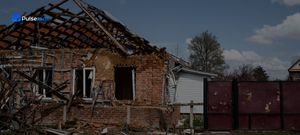Seismic Shifts: How Earthquake Risk Impacts Property Values in Vulnerable Regions
The perception of risk, particularly from natural disasters like earthquakes, can significantly influence real estate markets. This analysis delves into the correlation between earthquake risk scores and property values in seismically active cities, exploring how risk perception influences buyer behavior and investment decisions. We will examine data related to risk index scores, specific hazards, and population figures to understand these dynamics.
Understanding the Risk Landscape
To begin, let's consider the overall risk index scores across several cities. San Antonio, WA, for example, has a risk index score of 95, indicating a high overall risk from various hazards. In contrast, Phoenix, AZ, presents a much lower risk index score of 18. This difference in risk perception can play a crucial role in property valuation and buyer interest.
The data reveals a complex interplay of various hazards. For instance, Miami, CO, has a risk index score of 92. Breaking down the hazards, Miami, CO, faces a flood risk of 27, a wildfire risk of 82, a hurricane risk of 8, a tornado risk of 68, and an earthquake risk of 23. On the other hand, Portland, GA, has a risk index score of 15, with a flood risk of 11, a wildfire risk of 73, a hurricane risk of 4, a tornado risk of 49, and an earthquake risk of 77.
Analyzing Specific Hazards
Earthquake risk is a primary focus of this analysis. Dallas, OR, shows an earthquake risk of 87. Comparing this to Phoenix, AZ, with an earthquake risk of 16, we can infer that earthquake concerns might be more pronounced in Dallas, OR. This perception could influence property values and insurance rates.
However, it's essential to consider other hazards as well. Seattle, OR, has an earthquake risk of 39, but also faces a flood risk of 58 and a wildfire risk of 79. The combined impact of these hazards contributes to the overall risk perception and can affect real estate decisions.
Population Density and Risk Perception
Population density can also play a role in how risk is perceived and managed. Seattle, OR, has a population of 1013377, making it a densely populated area. In contrast, San Antonio, WA, has a population of 105983. Higher population densities might lead to increased awareness and preparedness for natural disasters, potentially mitigating the negative impact on property values.
Comparative Analysis of Cities
Let's compare a few cities directly to understand the nuances of risk and its potential impact on real estate. Denver, GA, has a risk index score of 40, with an earthquake risk of 83. Meanwhile, Portland, GA, has a risk index score of 15, but a lower earthquake risk of 77. Despite Denver, GA, having a higher overall risk index score, the higher earthquake risk in Denver, GA, could still be a concern for potential homebuyers.
Another interesting comparison is between two cities named Phoenix. Phoenix, AZ, has a risk index score of 18 and an earthquake risk of 16, while Phoenix, TN, has a risk index score of 94 and an earthquake risk of 64. The significant difference in risk scores and earthquake risk highlights the importance of considering location-specific factors when assessing real estate investments.
Exploring Additional Data Points
Further data exploration reveals additional insights. Tampa, GA, has a risk index score of 93, with an earthquake risk of 97. This high earthquake risk, combined with other hazards like floods (42), wildfires (76), and hurricanes (55), could significantly impact property values and buyer behavior in Tampa, GA.
Seattle, OR, from the second data set, has a risk index score of 74 and an earthquake risk of 44. This contrasts with Seattle, CA, which has a risk index score of 38 and an earthquake risk of 33. The differences in risk profiles between cities with the same name but in different states underscore the importance of detailed location-specific analysis.
The Impact on Real Estate Markets
While specific real estate metrics like median price, homes sold, inventory, and days on market are not available in this dataset, the risk index scores and hazard-specific data provide valuable context for understanding potential market dynamics. Cities with higher risk scores, particularly for earthquakes, might experience lower property values, longer selling times, and increased insurance costs. Conversely, cities with lower risk scores might attract more buyers and investors, leading to higher property values and faster sales.
Conclusion
The correlation between earthquake risk and property values is complex and influenced by various factors, including overall risk perception, specific hazard risks, population density, and location-specific characteristics. While this analysis lacks specific real estate metrics, the available data provides a foundation for understanding how risk can impact real estate markets in seismically active regions. Further research incorporating detailed property data is needed to fully quantify these relationships and inform investment decisions.



